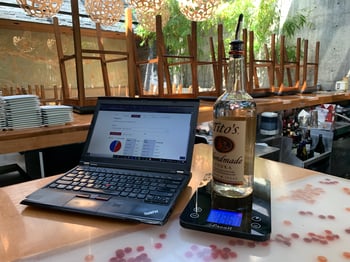Most bars have experienced a bouncing liquor cost on occasion. This refers to a situation where your liquor cost varies by more than 2 percentage points from period to period. A bouncing liquor cost is generally due to an error in your inventory process, unless there is some specific event that might have caused the change.
It should come as no surprise that you’re likely to experience errors during your liquor inventory audits. This is a manual process conducted by humans, and this creates the ideal conditions for errors to occur.
There Are Many Potential Sources of Errors in the Liquor Inventory Process
 While the counting process provides the easiest and most likely source of your errors, it’s not the only place where they may potentially occur. There are a lot of other components to a liquor inventory audit.
While the counting process provides the easiest and most likely source of your errors, it’s not the only place where they may potentially occur. There are a lot of other components to a liquor inventory audit.
You also need to integrate your purchases to calculate how much alcohol has been used, and you must integrate your sales for each individual item so you can compare how much was used vs. poured. Both of these tasks create an opportunity for errors to creep into your process.
Errors Slow Down Your Entire Liquor Inventory Process
Integrating purchases and sales, finding and resolving errors, and using the results of your audits to follow up with your staff in order to improve your bar’s performance is very time consuming. It equates to roughly half the time spent on liquor inventory each cycle. The other half of the time is devoted to counting.
Finding and resolving errors can be extremely time consuming. As a result, these errors considerably slow down the inventory process. By creating a system that reduces the likelihood of errors in the counting process, you can reduce the overall time spent on inventory.
Potential Solutions to Identify Errors and Eliminate a Bouncing Liquor Cost
If your bar is doing inventory primarily to calculate liquor cost by category, you often get a bouncing liquor cost from the errors that occur throughout the liquor inventory process. In these situations, it’s almost impossible to find these errors because you don’t know where to start looking for them. You don’t have the level of detail necessary to find the errors.
There are two potential solutions that will make it much easier to identify the source of your errors:
- Down to the serving inventory
- Zone counts
Down to the Serving Inventory
 Using Bar-i’s liquor inventory system or any other down to the serving inventory approach provides the benefit of tracking servings sold vs. poured for every product at your bar. This level of detail allows you to easily see errors by comparing the expected and actual inventory totals for every item you count.
Using Bar-i’s liquor inventory system or any other down to the serving inventory approach provides the benefit of tracking servings sold vs. poured for every product at your bar. This level of detail allows you to easily see errors by comparing the expected and actual inventory totals for every item you count.
If you have a detailed inventory process, you know what you counted last week. That number, which becomes the starting value of your current count, will have been checked and is therefore accurate. You also know what has been purchased during the current inventory period (you have the invoices to provide this information), and you know what has been sold (your POS report provides this information). You can then run your POS report through a recipes module that will calculate exactly how many ounces were poured during the inventory cycle.
If you know what you started with, how much you added through purchases and how much you depleted your inventory through sales, you know what your expected inventory value should be. You can then compare your actual inventory value to this expected value. If there’s a significant variance in these values (i.e., more than a 5% variance), then it’s a sign that an error has occurred. This lets you know you need to go back through your work to find and resolve the errors associated with that specific product.
Zone Counts
While it will be easier to find your errors with a down to the serving inventory process, it is still time consuming. You can easily spend a half hour on each error you’re trying to resolve. Therefore, taking additional steps to reduce the likelihood of making an error will help you significantly improve your accuracy and cut down on the overall time spent on the inventory process. The most effective way to achieve this goal is to do zone counts.
Zone counts are an effective solution to quickly identify errors the moment they occur so that they are fixed before you enter these incorrect numbers into your inventory spreadsheet. Here’s how you incorporate zone counts into your inventory process:
- Break up your counts into bite sized zones (each zone usually consists of 1 shelf in a storage area)
- Each time you count a zone, you count the specific number of bottles for each product and record this information
- Before you go on to count the next zone, count the total number of bottles on the shelf to make sure that total matches the sum of all the individual bottles for each different product you counted on that shelf
- If these numbers are different, you know you need to recount the zone since an error has occurred
When you use Bar-i’s inventory software, it provides you with the total aggregate count for each zone, making it easy (and faster) to confirm you have the right number.
Where Should I Use Zone Counts?
Zone counts work best when you’re counting full bottle areas. This includes full bottle counts in your storage area for liquor, wine and kegs of beer.
They don’t work as well when you’re counting bottles of beer because you often have mixed count units. In other words, you may have cases of 24 bottles alongside 6-packs and 12-packs. These different units make it hard to accurately count what’s in each zone.
In addition, there might be hundreds of bottles in a specific zone, making it harder to count that large of a total accurately. In comparison, there are vastly fewer liquor bottles on any given shelf (rarely more than 50), making it much easier to count them quickly and accurately.
Combining These Two Methods Will Significantly Improve Your Error Resolution Process
Having errors in your inventory counts reduces the effectiveness of your inventory efforts, but you’re always guaranteed to have them. If you use a more detailed approach that compares expected values to actual values and combine this with zone counts, you can really cut down these errors. This will make your inventory numbers much more accurate and useful, allowing you to leverage your inventory efforts to increase your bar’s profits by as much as 30%.
Zone counts actually slow down your counting time, but they increase the overall speed of the inventory process by significantly reducing the number of errors that occur during your counts. When combined with the increased accuracy you achieve, it makes this approach a powerful tool to help streamline your inventory process and improve the actionable results you generate from your efforts.
Contact us today to find out how Bar-i’s inventory software can help you streamline your operations and boost profits. We serve bars and restaurants nationwide from our offices in Denver, Colorado.


-1.png)